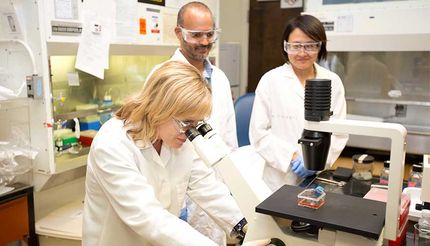UF scientists devise new way to analyze epidemics
Advertisement
An international team of researchers led by the University of Florida has created a new way to analyze the spread of dangerous viruses, according to a study published in Nature Communications.
The method uses sets of mathematical rules to do something software cannot easily accomplish — analyze subtle DNA differences to more fully understand health threats such as HIV, hepatitis or even influenza.
“We applied this technique to more than 7,000 patients with a subtype of HIV-1,” said Mattia Prosperi, Ph.D., a postdoctoral associate at UF’s Emerging Pathogens Institute and the Genetics Institute. “We were able to confirm transmission within established risk groups, identify infection hubs, and we also saw that transmission does not respect the boundaries of the risk groups.”
Information about sexual habits, intravenous drug use and other behaviors or characteristics that play a role in HIV transmission can be found through comprehensive interviews with large numbers of people. But even with that exhaustive analysis, the fine elements concerning the distribution of the virus can be unclear.
The new technique can ascertain similar information — and more — by taking DNA sequences from patients and partitioning them according to differences in how the virus evolved. By quickly characterizing how the virus spreads, researchers can discover information about the demographics of the people being infected and the drug-resistance of the virus. The information can shape prevention measures to thwart potential epidemics.
“Ways to look at DNA sequences and compare how a pathogen moves from one person to the next has been a computational problem for more than 10 years,” said co-author Marco Salemi, Ph.D., an assistant professor of pathology, immunology and laboratory medicine and a member of and graduate instructor with the UF Genetics Institute. “It is important to have a statistically sound method to follow the spread of viruses in populations and detect transmission chains — the networks of people who transmit the infection to each other — to develop strategies to control an epidemic.”
The technique in the Nature Communications study could be applied to any bacterial or viral threat, but UF researchers along with colleagues from the University of Rome studied how an emerging HIV-1 subtype circulated among different risk groups in Italy.
Using data obtained from the Antiretroviral Resistance Cohort Analysis, a nationwide Italian HIV resistance data repository, scientists discovered people who recently acquired HIV-1 were effectively acting as infection hubs, playing a dramatic role in the spread of the disease before they actually displayed any symptoms. In addition, the study showed infections were not exclusive to the risk groups.
“The HIV example shows a strong strategy needs to be in place to educate people that if they are in a risk group, they shouldn’t wait until symptoms appear before being tested,” Prosperi said. “It also shows the transmission route is not always clear, and people should not assume that they are excluded from contracting HIV.”
Researchers said the technique can reveal valuable information in viruses as common as the flu, such as whether it is spreading along transportation routes or among people in certain occupations.


























































